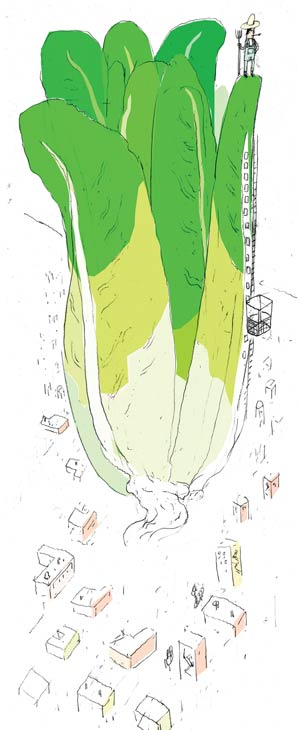Is a 60-storey skyscraper the farm of the future?
Paul McLaughlinWebsite

How to get local produce in the city? Look up. Illustration by Peter Mitchell.
Canadian architecture student Gordon Graff attracted worldwide interest when he designed SkyFarm, a 59-storey farm for downtown Toronto.
What inspired you to design a vertical farm?
Sometime in 2006, when I was first working on my masters at the University of Waterloo, I knew I wanted to focus on how to turn a city like Toronto into a truly ecologically sustainable city. What frustrated me was that food was rarely in the discussion. It was all about reducing energy use and other fantastic things, but a big issue like the security of the food source of a city and the negative ecological impact of agriculture on the earth never came into the discussion. So I just sort of drifted toward the notion that it would be great if somehow we could actually produce food within cities.
What happened next?
In 2006 I was researching hydroponic configurations, and I came across a website for Dr. Dickson Despommier [a professor of environmental health science at Columbia University] called verticalfarm.com. Here was a professor not connected to architecture who was pushing for skyscraper farms. It was another actual voice out there, giving an academic basis to what I was doing. Around the same time I saw there was a competition to design skyscrapers, and everything just clicked.
You called your design SkyFarm.
I did it rather hastily, and it didn’t win. But Dickson put my drawing on his website and there was an incredible viral spreading of the design. BCME, an Australian publication, put it in their magazine. Global TV interviewed me. When the architecture magazine Azure said it wanted to do a story featuring the design, I figured I should put something better forward, and that led to the current iteration of the design.
This is the 60-storey building you proposed for downtown Toronto.
Yeah. It would have 2.7 million square feet of floor area and 9.5 million square feet of growing area and could feed about 40,000 people a year.
What are the main features of the building?
It’s really just a high-density hydroponic farm that has food growing on different floors. The building’s structure would be similar to that of a commercial or residential high-rise except for some small details. It would be a lot like a conventional greenhouse except the lighting would be artificial instead of sunlight.
What kind of lighting would you use?
LCD grow lights. Some would be on 24 hours a day, so the building would glow at night.
So it would use an awful lot of energy—
—and a lot of water.
How would you compensate for those requirements?
The building would have two key components: a small biogas plant and a “living machine.” The biogas plant would collect methane (natural gas) from the farm’s abundant plant waste, the grass “silage” growing on the south-facing wall, as well as the city’s sewers. The methane would be used to power a generator to deliver electricity to the building. The living machine would filter the farm’s water, recycling it back into the farm rather than into the city’s waste water system. With these two components in place, the SkyFarm would be extremely resource efficient.
What could be grown?
Technically any crop, but a few like rice, which requires a lot of water, are probably too costly to grow.
Is there any reason a vertical farm wouldn’t work?
There are definitely hurdles to overcome, but technologically and economically, vertical farms are viable. They just need the first investments by investors and/or governments to become a reality.
What’s the next step for you with this project?
After my master’s thesis is finished later this summer I plan to formalize a business plan for my design of a vertical farm embedded within a condo—an “agro-arcology.” I’ve been approached by a few developers about the concept, so the logical next step is to create a proper cost analysis.